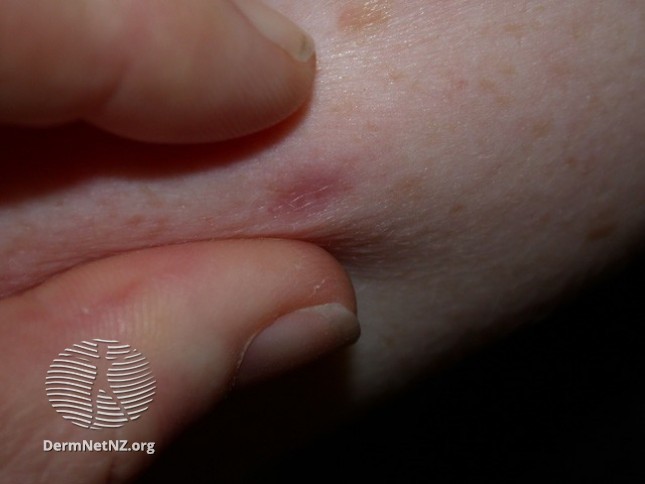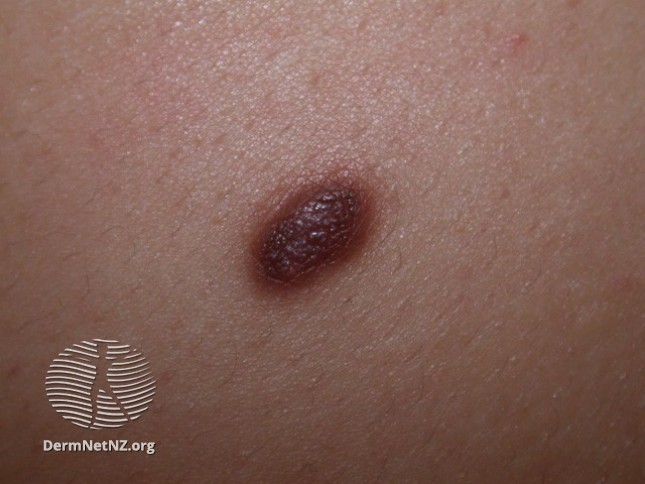Dermatofibroma physical examination: Difference between revisions
Homa Najafi (talk | contribs) No edit summary |
m (Bot: Removing from Primary care) |
||
| (15 intermediate revisions by 3 users not shown) | |||
| Line 1: | Line 1: | ||
__NOTOC__ | |||
{{Dermatofibroma}} | {{Dermatofibroma}} | ||
{{CMG}};{{AE}}{{Homa}} {{KS}} | {{CMG}};{{AE}}{{Homa}} {{KS}} | ||
==Overview== | ==Overview== | ||
[[Physical examination]] of [[patients]] with dermatofibroma is usually shows a non-tender, [[Pigment|hyperpigmented]] [[Nodule (medicine)|nodule]] with 0.3 to 1 [[Centimetre|cm]] in [[diameter]] which dimple sign may be positive. It can seen in any part of the [[body]] but [[extremities]], especially [[legs]] are most common sites. | |||
==Physical Examination== | ==Physical Examination== | ||
Physical examination of patients | [[Physical examination]] of [[patients]] with dermatofibroma is usually shows a non-tender, [[Pigment|hyperpigmented]] [[Nodule (medicine)|nodule]] with 0.3 to 1 [[Centimetre|cm]] in [[diameter]] which dimple sign may be positive. It can seen in any part of the [[body]] but [[extremities]], especially [[legs]] are most common sites. | ||
===Skin=== | ===Skin=== | ||
*[[Skin]] [[examination]] of [[patients]] with dermatofibroma may show:<ref name="LeeLee2015">{{cite journal|last1=Lee|first1=MiWoo|last2=Lee|first2=WooJin|last3=Jung|first3=JoonMin|last4=Won|first4=ChongHyun|last5=Chang|first5=SungEun|last6=Choi|first6=JeeHo|last7=Moon|first7=KeeChan|title=Clinical and histological patterns of dermatofibroma without gross skin surface change: A comparative study with conventional dermatofibroma|journal=Indian Journal of Dermatology, Venereology, and Leprology|volume=81|issue=3|year=2015|pages=263|issn=0378-6323|doi=10.4103/0378-6323.154795}}</ref><ref name="MentzelWiesner2012">{{cite journal|last1=Mentzel|first1=Thomas|last2=Wiesner|first2=Thomas|last3=Cerroni|first3=Lorenzo|last4=Hantschke|first4=Markus|last5=Kutzner|first5=Heinz|last6=Rütten|first6=Arno|last7=Häberle|first7=Michael|last8=Bisceglia|first8=Michele|last9=Chibon|first9=Frederic|last10=Coindre|first10=Jean-Michel|title=Malignant dermatofibroma: clinicopathological, immunohistochemical, and molecular analysis of seven cases|journal=Modern Pathology|volume=26|issue=2|year=2012|pages=256–267|issn=0893-3952|doi=10.1038/modpathol.2012.157}}</ref><ref name="FitzpatrickGilchrest1977">{{cite journal|last1=Fitzpatrick|first1=Thomas B.|last2=Gilchrest|first2=Barbara A.|title=Dimple Sign to Differentiate Benign from Malignant Pigmented Cutaneous Lesions|journal=New England Journal of Medicine|volume=296|issue=26|year=1977|pages=1518–1518|issn=0028-4793|doi=10.1056/NEJM197706302962610}}</ref><ref>{{Cite journal | |||
| author = [[Marc Pusztaszeri]], [[Pierre-Yves Jaquet]] & [[Carole Williamson]] | |||
*[[ | | title = Giant hemosiderotic dermatofibroma: a case report and review of the literature | ||
| journal = [[Case reports in dermatology]] | |||
| volume = 3 | |||
| issue = 1 | |||
| pages = 32–36 | |||
< | | year = 2011 | ||
| month = | |||
| doi = 10.1159/000324721 | |||
| pmid = 21487458 | |||
|url=|first=|date=|via=}}</ref><ref>{{Cite journal | |||
</ | | author = [[L. Requena]], [[M. C. Farina]], [[C. Fuente]], [[E. Pique]], [[M. Olivares]], [[L. Martin]] & [[E. Sanchez Yus]] | ||
| title = Giant dermatofibroma. A little-known clinical variant of dermatofibroma | |||
=== | | journal = [[Journal of the American Academy of Dermatology]] | ||
| volume = 30 | |||
| issue = 5 Pt 1 | |||
| pages = 714–718 | |||
| year = 1994 | |||
| month = | |||
| pmid = 8176009 | |||
|url=|first=|date=|via=}}</ref> | |||
**[[Nodule (medicine)|Nodule]] with 0.3 to 1 [[Centimetre|cm]] in [[diameter]] | |||
***'''Note''' : Giant (> 5 [[Centimetre|cm]]) are also reported. | |||
** Non-tender [[nodule]] | |||
***'''Note''': Manipulation can cause [[tenderness]]. | |||
**[[Hyperpigmentation]] | |||
**[[Dimple]] [[Medical sign|sign]] ([[lateral]] compression on the [[skin]] makes a depression) | |||
***'''Note''': [[Dimple]] [[Medical sign|sign]] can also seen in other [[skin changes]]. | |||
** Puritic [[Nodule (medicine)|nodule]] (may happen by [[superinfection]]) | |||
[[File:Dimple sign.jpg|350px|thumb|https://www.dermnetnz.org/topics/dermatofibroma-images/|center]] | |||
[[File:Hyperpigmentation in dermatofibroma.jpg|350px|thumb|https://www.dermnetnz.org/topics/dermatofibroma-images/|center]] | |||
=== | |||
= | |||
=== | |||
* | |||
*[[ | |||
*[[ | |||
*[[ | |||
*[[ | |||
* | |||
* | |||
* | |||
* | |||
*[[ | |||
* | |||
* | |||
===Extremities=== | ===Extremities=== | ||
*[[Extremities]] are the most common site of dermatofibromas, especially [[Leg|legs]].<ref name="ŞenelYuyucu Karabulut2015">{{cite journal|last1=Şenel|first1=E.|last2=Yuyucu Karabulut|first2=Y.|last3=Doğruer Şenel|first3=S.|title=Clinical, histopathological, dermatoscopic and digital microscopic features of dermatofibroma: a retrospective analysis of 200 lesions|journal=Journal of the European Academy of Dermatology and Venereology|volume=29|issue=10|year=2015|pages=1958–1966|issn=09269959|doi=10.1111/jdv.13092}}</ref><ref name="HanChang2011">{{cite journal|last1=Han|first1=Tae Young|last2=Chang|first2=Hee Sun|last3=Lee|first3=June Hyun Kyung|last4=Lee|first4=Won-Mi|last5=Son|first5=Sook-Ja|title=A Clinical and Histopathological Study of 122 Cases of Dermatofibroma (Benign Fibrous Histiocytoma)|journal=Annals of Dermatology|volume=23|issue=2|year=2011|pages=185|issn=1013-9087|doi=10.5021/ad.2011.23.2.185}}</ref> | |||
*[[ | |||
==References== | ==References== | ||
{{reflist|2}} | {{reflist|2}} | ||
[[Category:Medicine]] | |||
[[Category: | |||
[[Category:Oncology]] | [[Category:Oncology]] | ||
[[Category: | [[Category:Up-To-Date]] | ||
[[Category:Dermatology]] | [[Category:Dermatology]] | ||
Latest revision as of 21:18, 29 July 2020
|
Dermatofibroma Microchapters |
|
Diagnosis |
|---|
|
Treatment |
|
Case Studies |
|
Dermatofibroma physical examination On the Web |
|
American Roentgen Ray Society Images of Dermatofibroma physical examination |
|
Risk calculators and risk factors for Dermatofibroma physical examination |
Editor-In-Chief: C. Michael Gibson, M.S., M.D. [1];Associate Editor(s)-in-Chief: Homa Najafi, M.D.[2] Kiran Singh, M.D. [3]
Overview
Physical examination of patients with dermatofibroma is usually shows a non-tender, hyperpigmented nodule with 0.3 to 1 cm in diameter which dimple sign may be positive. It can seen in any part of the body but extremities, especially legs are most common sites.
Physical Examination
Physical examination of patients with dermatofibroma is usually shows a non-tender, hyperpigmented nodule with 0.3 to 1 cm in diameter which dimple sign may be positive. It can seen in any part of the body but extremities, especially legs are most common sites.
Skin
- Skin examination of patients with dermatofibroma may show:[1][2][3][4][5]
- Nodule with 0.3 to 1 cm in diameter
- Note : Giant (> 5 cm) are also reported.
- Non-tender nodule
- Note: Manipulation can cause tenderness.
- Hyperpigmentation
- Dimple sign (lateral compression on the skin makes a depression)
- Note: Dimple sign can also seen in other skin changes.
- Puritic nodule (may happen by superinfection)
- Nodule with 0.3 to 1 cm in diameter


Extremities
- Extremities are the most common site of dermatofibromas, especially legs.[6][7]
References
- ↑ Lee, MiWoo; Lee, WooJin; Jung, JoonMin; Won, ChongHyun; Chang, SungEun; Choi, JeeHo; Moon, KeeChan (2015). "Clinical and histological patterns of dermatofibroma without gross skin surface change: A comparative study with conventional dermatofibroma". Indian Journal of Dermatology, Venereology, and Leprology. 81 (3): 263. doi:10.4103/0378-6323.154795. ISSN 0378-6323.
- ↑ Mentzel, Thomas; Wiesner, Thomas; Cerroni, Lorenzo; Hantschke, Markus; Kutzner, Heinz; Rütten, Arno; Häberle, Michael; Bisceglia, Michele; Chibon, Frederic; Coindre, Jean-Michel (2012). "Malignant dermatofibroma: clinicopathological, immunohistochemical, and molecular analysis of seven cases". Modern Pathology. 26 (2): 256–267. doi:10.1038/modpathol.2012.157. ISSN 0893-3952.
- ↑ Fitzpatrick, Thomas B.; Gilchrest, Barbara A. (1977). "Dimple Sign to Differentiate Benign from Malignant Pigmented Cutaneous Lesions". New England Journal of Medicine. 296 (26): 1518–1518. doi:10.1056/NEJM197706302962610. ISSN 0028-4793.
- ↑ Marc Pusztaszeri, Pierre-Yves Jaquet & Carole Williamson (2011). "Giant hemosiderotic dermatofibroma: a case report and review of the literature". Case reports in dermatology. 3 (1): 32–36. doi:10.1159/000324721. PMID 21487458.
- ↑ L. Requena, M. C. Farina, C. Fuente, E. Pique, M. Olivares, L. Martin & E. Sanchez Yus (1994). "Giant dermatofibroma. A little-known clinical variant of dermatofibroma". Journal of the American Academy of Dermatology. 30 (5 Pt 1): 714–718. PMID 8176009.
- ↑ Şenel, E.; Yuyucu Karabulut, Y.; Doğruer Şenel, S. (2015). "Clinical, histopathological, dermatoscopic and digital microscopic features of dermatofibroma: a retrospective analysis of 200 lesions". Journal of the European Academy of Dermatology and Venereology. 29 (10): 1958–1966. doi:10.1111/jdv.13092. ISSN 0926-9959.
- ↑ Han, Tae Young; Chang, Hee Sun; Lee, June Hyun Kyung; Lee, Won-Mi; Son, Sook-Ja (2011). "A Clinical and Histopathological Study of 122 Cases of Dermatofibroma (Benign Fibrous Histiocytoma)". Annals of Dermatology. 23 (2): 185. doi:10.5021/ad.2011.23.2.185. ISSN 1013-9087.